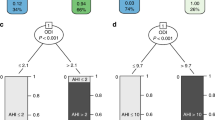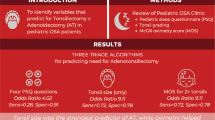Abstract
Objective
To investigate the effect of adenotonsillectomy on OSAS symptoms based on a data-driven approach and thereby identify criteria that may help avoid unnecessary surgery in children with OSAS.
Methods
In 323 children enrolled in the Childhood Adenotonsillectomy Trial, randomised to undergo either early adenotonsillectomy (eAT; N = 165) or a strategy of watchful waiting with supportive care (WWSC; N = 158), the apnea-hypopnea index, heart period pattern dynamics, and thoraco-abdominal asynchrony measurements from overnight polysomnography (PSG) were measured. Using machine learning, all children were classified into one of two different clusters based on those features. The cluster transitions between follow-up and baseline PSG were investigated for each to predict those children who recovered spontaneously, following surgery and those who did not benefit from surgery.
Results
The two clusters showed significant differences in OSAS symptoms, where children assigned in cluster A had fewer physiological and neurophysiological symptoms than cluster B. Whilst the majority of children were assigned to cluster A, those children who underwent surgery were more likely to stay in cluster A after seven months. Those children who were in cluster B at baseline PSG were more likely to have their symptoms reversed via surgery. Children who were assigned to cluster B at both baseline and 7 months after surgery had significantly higher end-tidal carbon dioxide at baseline. Children who spontaneously changed from cluster B to A presented highly problematic ratings in behaviour and emotional regulation at baseline.
Conclusions
Data-driven analysis demonstrated that AT helps to reverse and to prevent the worsening of the pathophysiological symptoms in children with OSAS. Multiple pathophysiological markers used with machine learning can capture more comprehensive information on childhood OSAS. Children with mild physiological and neurophysiological symptoms could avoid AT, and children who have UAO symptoms post AT may have sleep-related hypoventilation disease which requires further investigation. Furthermore, the findings may help surgeons more accurately predict children on whom they should perform AT.




Similar content being viewed by others
References
Baumert M, Pamula Y, Martin J et al (2016) The effect of adenotonsillectomy for childhood sleep apnoea on cardiorespiratory control. ERJ Open Research 2:00003–02016
Baumert M, Walther T, Hopfe J, Stepan H, Faber R, Voss A (2002) Joint symbolic dynamic analysis of beat-to-beat interactions of heart rate and systolic blood pressure in normal pregnancy. Med Biol Eng Compu 40:241–245
Berry RB, Budhiraja R, Gottlieb DJ et al (2012) Rules for scoring respiratory events in sleep: update of the 2007 AASM Manual for the Scoring of Sleep and Associated Events. Deliberations of the Sleep Apnea Definitions Task Force of the American Academy of Sleep Medicine. J Clin Sleep Med 8:597–619
Bhattacharjee R, Kheirandish-Gozal L, Spruyt K et al (2010) Adenotonsillectomy outcomes in treatment of obstructive sleep apnea in children: a multicenter retrospective study. Am J Respir Crit Care Med 182:676–683
Bozkurt S, Bostanci A, Turhan M (2017) Can statistical machine learning algorithms help for classification of obstructive sleep apnea severity to optimal utilization of polysomno graphy resources? Methods Inf Med 56:308–318
Brietzke SE, Gallagher D (2006) The effectiveness of tonsillectomy and adenoidectomy in the treatment of pediatric obstructive sleep apnea/hypopnea syndrome: a meta-analysis. Otolaryngology-Head and Neck Surgery 134:979–984
Chervin RD, Ellenberg SS, Hou X et al (2015) Prognosis for spontaneous resolution of OSA in children. Chest 148:1204–1213
Costa DJ, Mitchell R (2009) Adenotonsillectomy for obstructive sleep apnea in obese children: a meta-analysis. Otolaryngology-Head and Neck Surgery 140:455–460
Di-Tullio F, Ernst G, Robaina G et al (2018) Ambulatory positional obstructive sleep apnea syndrome. Sleep Science 11:8
El-Hamad F, Immanuel S, Liu X et al (2017) Altered Nocturnal Cardiovascular Control in Children With Sleep-Disordered Breathing. Sleep 40:zsx127
Guilleminault C, Huang Y-S, Chin W-C, Okorie C (2018) The nocturnal-polysomnogram and “non-hypoxic sleep-disordered-breathing” in children. Sleep medicine
Guilleminault C, Lee J, Chan A (2005) PEdiatric obstructive sleep apnea syndrome. Arch Pediatr Adolesc Med 159:775–785
Guilleminault C, Li K, Khramtsov A, Palombini L, Pelayo R (2004) Breathing patterns in prepubertal children with sleep-related breathing disorders. Arch Pediatr Adolesc Med 158:153–161
Immanuel S, Kohler M, Martin J et al (2014) Increased thoracoabdominal asynchrony during breathing periods free of discretely scored obstructive events in children with upper airway obstruction. Sleep Breath 19:65–71
Immanuel SA, Pamula Y, Kohler M et al (2012) Respiratory timing and variability during sleep in children with sleep-disordered breathing. J Appl Physiol 113:1635–1642
Jackman AR, Biggs SN, Walter LM et al (2012) Sleep-disordered breathing in preschool children is associated with behavioral, but not cognitive, impairments. Sleep Med 13:621–631
Jain AK (2010) Data clustering: 50 years beyond K-means. Pattern Recogn Lett 31:651–666
Katz ES, D’ambrosio CM (2010) Pediatric Obstructive Sleep Apnea Syndrome. Clinics in Chest Medicine 31:221–34
Kim T, Kim J-W, Lee K (2018) Detection of sleep disordered breathing severity using acoustic biomarker and machine learning techniques. Biomed Eng Online 17:16
Kontos A, Lushington K, Martin J et al (2017) Relationship between vascular resistance and sympathetic nerve fiber density in arterial vessels in children with sleep disordered breathing. Journal of the American Heart Association, 6: e006137
Kontos A, Van Den Heuvel C, Pamula Y et al (2015) Delayed brachial artery dilation response and increased resting blood flow velocity in young children with mild sleep-disordered breathing. Sleep Med 16:1451–1456
Kontos A, Willoughby S, Van Den Heuvel C et al (2018) Ascending aortic blood flow velocity is increased in children with primary snoring/mild sleep-disordered breathing and associated with an increase in CD8+ T cells expressing TNFα and IFNγ. Heart Vessels 33:537–548
Laing EE, Möller-Levet CS, Dijk D-J, Archer SN (2018) Identifying and validating blood mRNA biomarkers for acute and chronic insufficient sleep in humans: a machine learning approach. Sleep, 42
Liu X, Immanuel S, Kennedy D, Martin J, Pamula Y, Baumert M (2018a) Effect of adenotonsillectomy for childhood obstructive sleep apnea on nocturnal heart rate patterns. Sleep, 41: zsy171-zsy71
Liu X, Immanuel S, Pamula Y, Kennedy D, Martin J, Baumert M (2017) Adenotonsillectomy for childhood obstructive sleep apnoea reduces thoraco-abdominal asynchrony but spontaneous apnoea−hypopnoea index normalisation does not. European Respiratory Journal, 49
Liu X, Immanuel S, Pamula Y et al (2018b) Pulse wave amplitude and heart period variability in children with upper airway obstruction. Sleep Medicine
Liu X, Pamula Y, Kohler M, Baumert M (2019) A Method for Estimating Pulse Wave Amplitude Variability in children with Sleep Disordered Breathing. In), 2019 41st Annual International Conference of the IEEE Engineering in Medicine and Biology Society (EMBC): 2289–92
Lumeng JC, Chervin RD (2008) Epidemiology of pediatric obstructive sleep apnea. Proc Am Thorac Soc 5:242–252
Marcus CL, Brooks LJ, Ward SD et al (2012) Diagnosis and management of childhood obstructive sleep apnea syndrome. Pediatrics 130:e714–e755
Marcus CL, Moore RH, Rosen CL et al (2013) A Randomized Trial of Adenotonsillectomy for Childhood Sleep Apnea. N Engl J Med 368:2366–2376
Ng D, Chan C, Chow A, Chow P, Kwok K (2005) Childhood sleep-disordered breathing and its implications for cardiac and vascular diseases. J Paediatr Child Health 41:640–646
Nisbet LC, Yiallourou SR, Walter LM, Horne RS (2014) Blood pressure regulation, autonomic control and sleep disordered breathing in children. Sleep Med Rev 18:179–189
Rapoport DM (2016) POINT: Is the apnea-hypopnea index the best way to quantify the severity of sleep-disordered breathing? Yes. Chest 149:14–16
Redline S, Amin R, Beebe D et al. "Childhood Adenotonsillectomy Study." National Sleep Research Resource. Web. http://sleepdata.org/datasets/chat.
Redline S, Amin R, Beebe D et al (2011) The Childhood Adenotonsillectomy Trial (CHAT): Rationale, Design, and Challenges of a Randomized Controlled Trial Evaluating a Standard Surgical Procedure in a Pediatric Population. Sleep 34:1509–1517
Spruyt K, Verleye G, Gozal D (2010) Unbiased Categorical Classification of Pediatric Sleep Disordered Breathing. Sleep 33:1341–1347
Suen JS, Arnold JE, Brooks LJ (1995) Adenotonsillectomy for treatment of obstructive sleep apnea in children. Archives of Otolaryngology-Head & Neck Surgery 121:525–530
Tamanyan K, Walter LM, Weichard A et al (2018) Age effects on cerebral oxygenation and behavior in children with sleep-disordered breathing. Am J Respir Crit Care Med 197:1468–1477
Zhang Z, Mayer G, Dauvilliers Y et al (2018) Exploring the clinical features of narcolepsy type 1 versus narcolepsy type 2 from European Narcolepsy Network database with machine learning. Sci Rep 8:10628
Acknowledgements
We would like to thank Michael Rueschman, Division of Sleep and Circadian Disorders, Brigham and Women’s Hospital, Boston, MA, USA for support with handling and interpreting the CHAT dataset. Xiao Liu, Sarah Immanuel, and Mathias Baumert had full access to all of the data in the study and take responsibility for the integrity of the data and the accuracy of the data analysis. Yvonne Pamula, James Martin, and Declan Kennedy contributed substantially to the interpretation and the writing of the manuscript.
Funding
The Childhood Adenotonsillectomy Trial (CHAT) was supported by the National Institutes of Health (HL083075, HL083129, UL1-RR-024134, UL1 RR024989). The National Sleep Research Resource was supported by the National Heart, Lung, and Blood Institute (R24 HL114473, 75N92019R002).
Author information
Authors and Affiliations
Corresponding authors
Ethics declarations
Ethical approval
All procedures performed in studies involving human participants were in accordance with the ethical standards of the institutional research committee of each paticipating institution and with the 1964 Helsinki declaration and its later amendments or comparable ethical standards.
Informed consent
Informed consent was obtained from all individual participants included in the study.
Conflict of interest
All authors certify that they have no affiliations with or involvement in any organisation or entity with any financial interest (such as honoraria; educational grants; participation in speakers' bureaus; membership, employment, consultancies, stock ownership, or other equity interest; and expert testimony or patent-licencing arrangements), or nonfinancial interest (such as personal or professional relationships, affiliations, knowledge or beliefs) in the subject matter or materials discussed in this manuscript.
Additional information
Publisher's Note
Springer Nature remains neutral with regard to jurisdictional claims in published maps and institutional affiliations.
Statement of significance
This study shows that machine learning can help stratify children with obstructive sleep apnea syndrome. We identified previously unreported baseline differences in children who reversed cardiorespiratory symptoms spontaneously and therefore, could avoid surgery. The combination of OAHI3, N2 event-free heart period pattern dynamics and N3 event-free thoraco-abdominal asynchrony measurements may help identify children with mild-to-moderate symptoms who do not require surgery.
Supplementary Information
Below is the link to the electronic supplementary material.
Rights and permissions
About this article
Cite this article
Liu, X., Pamula, Y., Immanuel, S. et al. Utilisation of machine learning to predict surgical candidates for the treatment of childhood upper airway obstruction. Sleep Breath 26, 649–661 (2022). https://doi.org/10.1007/s11325-021-02425-w
Received:
Revised:
Accepted:
Published:
Issue Date:
DOI: https://doi.org/10.1007/s11325-021-02425-w




